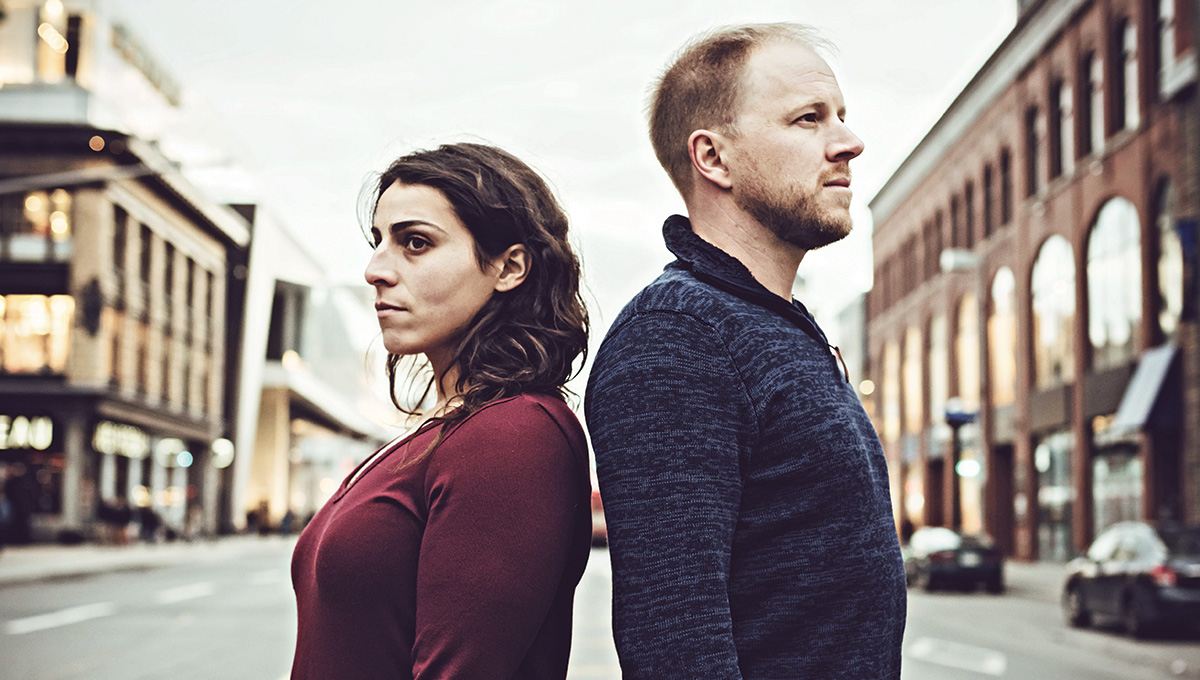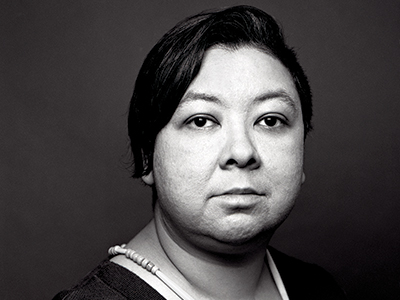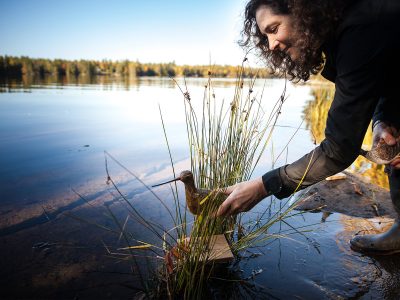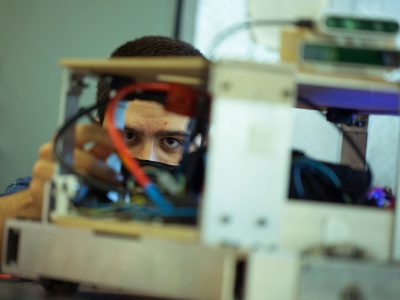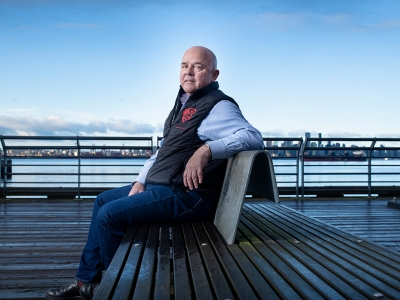Photos by Martin Lipman
Charlotte Smith is a sociology master’s student at Carleton. Her research is exploring the experiences of homeless youth, many of whom struggle with substance abuse — two major threads in her own life. Jeff Smith (no relation) is a chemistry professor and director of the Carleton Mass Spectrometry Centre. One of his projects is using mass spec — an analysis technique that can determine the molecular structure of a substance — to find out what’s in the drugs that people bring to the supervised injection site at Ottawa’s Sandy Hill Community Health Centre. — as told to Dan Rubinstein
Charlotte Smith: I moved to Canada from England in 2002 when I was 12 to be with my biological mother. My adopted uncle had been sexually abusing me since I was four or five. My mum gave me a choice: stay in England and she would tell the police and I would have to go to court and talk about everything, or come with her. She was in Dunrobin, outside Ottawa. We had a lovely honeymoon period, like we were the Gilmore Girls, then it deteriorated. She didn’t have any other kids and I wasn’t the way she wanted me to be. Even my Yorkshire accent upset her because she had grown up in a different part of England.
Jeff Smith: As a teenager, I really got good marks in science. The fact that right answers were right and wrong answers were wrong, and that the data either supports a hypothesis or doesn’t, I found that appealing. I liked putting my efforts towards outcomes that weren’t based on opinions. In my undergrad, I did a lot of chemistry and biochemistry. In grad school, I got into mass spectrometry, which allowed me to work with my hands and analytical equipment to come up with data that gave me a better understanding of how biological systems worked.
Charlotte: The week before my mum kicked me out, when I was 15, she dragged me to the Children’s Hospital of Eastern Ontario (CHEO), to the psych ward, because I’d been cutting my arm. I was in this new country and was so homesick. My mother begged CHEO to admit me: “She’s a danger to herself!” And they were like, “She’s not — she’s just a teenager.” Mum couldn’t handle it, and a week later she dropped me off at a foster home. I was so afraid. A few weeks after that, I started letting the foster dad have sex with me. I saw this guy at the top of the stairs and thought, “OK, I’m safe now, I’m going to make this my family,” and I hugged him. He told me later, “When you hugged me I knew you were in love with me and we were going to be together.” How can one person be thinking one thing and another person something completely different?

Charlotte Smith
Jeff: The drug checking project started when a harm reduction worker from the AIDS Committee of Ottawa (ACO) approached Carleton Front Door, an initiative we launched with the goal of working with the community to find new ways of dealing with problems that people are facing. I’ve used mass spec to work with a coffee company and a craft brewery and was meeting with a lot of potential partners from the food industry, and he asked whether a mass spectrometer could tell us what’s inside street drugs. I also do research on cancer therapies, but public health issues like the opioid crisis were not on my radar. Mass spectrometry was basically built by the pharmaceutical industry to analyze drugs, which is the field’s main bread and butter. I took a quick survey of the main molecular structures of opioids. All of them are highly conducive to analysis by mass spec.
Charlotte: The foster home dissolved and all the kids lost their placements when the wife called the police. I was still trying to attend school and wasn’t doing well. I floated between working on and sleeping at farms and staying with my former foster dad. That’s when I started doing drugs. When my mum kicked me out she suspected I had been doing drugs, even though I had never even tried pot. So I said, “Fuck it — everyone thinks I’m a junkie anyways, I’m just gonna do whatever I can.” I started popping ecstasy and speed and any pills I could get my hands on. I had switched to an alternative high school and drugs were easy to get.
Jeff: A mass spectrometer is like a very sensitive balance. You take a sample that contains different molecules. The instrument puts a charge on each molecule that turns them into ions. Those ions, because they’re charged, can be manipulated by an electric field. Based on how they move, you can determine what their mass is, and when you know the mass of a molecule you know its identity. Conventional mass spectrometers take up an entire bench top, need 30 minutes to do an analysis and consume nitrogen gas. A new one costs about $500,000. They have pumps and fans that whir and buzz loudly. To a pharmaceutical company, none of this is big deal — it’s the cost of doing science.
Charlotte: I didn’t consider myself homeless even though things like couch surfing and survival sex for shelter fall under the definition of homelessness. When I met somebody who had been prescribed OxyContin, I became street-level homeless. She gave me a couple pills and I taught her how to snort them, which gets you way higher. I didn’t realize they were so addictive. She’s dead now. It was a huge mistake, although Oxy gave me the courage to finally leave the foster dad. I moved in with a bunch of people who were addicted to Oxy. That lasted less than a month. Eventually I started sleeping in cars with people who were using drugs, and then on the streets. Not all homeless young people do drugs, but many of the ones I have met do. It’s escape. Even now, I constantly feel like I don’t want to be inside my own body.
Jeff: I went to a mass spectrometry conference in the U.S. in 2017 and, amongst hundreds of booths set up by people from industry, I saw a prototype I had never seen before. It was from a company called BaySpec, which had gotten a contract from the American military to build an unique new mass spectrometer. It was about 13 inches by 16 inches by 9 inches high and weighed 22 pounds. The military wanted to strap these things to the bottom of vehicles and use them to drag a probe along the ground to test for chemical warfare agents. I asked, “Have you thought about using it for anything else?”
Charlotte: I was in and out of jail, and every time I got released, it was the same: I’d go straight back downtown, back to crack. All the social services and support that people need are downtown, so even if you’re trying to get help, you’re putting yourself into a high-risk situation. If somebody was picking me up from jail and we weren’t smoking crack in the car, then we were going to get some. Crack was my drug of choice, but I also used Oxy and heroin and morphine — any type of downer I could get just to keep from being sick from withdrawal.
Jeff: Lynne Leonard, a social epidemiologist at the University of Ottawa, and her research team, along with the ACO, secured funding from the Canadian Institutes of Health Research (CIHR) towards understanding the ramifications of telling a drug user what’s in their sample. Does it cause them to act any differently when they know what’s in their syringe? Through the CIHR grant, I was able to broker a deal. BaySpec gave us the instrument for a free 30-day trial, we took it to the Sandy Hill supervised injection site, and I was convinced in about 20 minutes. It blew my mind how well this instrument worked. We saw all the different components of the drugs immediately.
Charlotte: One time, when I was getting out of jail, I was able to reach a friend from elementary school, Seb, and he took me straight to Orleans. There, Seb and others encouraged me and helped me to get a job on a horse farm. I didn’t come into Ottawa for a year and a half, because I couldn’t be around any drugs. I was very happy getting paid 50 bucks a day for 10 hours of shovelling horse shit. One of the girls who owned a horse on the farm, Jennifer, became my friend and helped me apply to Carleton. She helped me write about my life. That’s one of the things people don’t understand about homelessness and drug use — it’s so important who you know. When everybody else is struggling with the same issues as you, there’s nobody to lead you out.
Jeff: Once we realized it was going to work, we bought the instrument through the CIHR funds and have been using it in Sandy Hill for more than a year. For me, it’s been eye-opening exposure to a world I didn’t know anything about. Clients bring their own pills, which they crush and heat with water in a cooker — a small metal bowl — which dissolves the drug into a liquid that they pull into their syringe. A lot of times they’ll set the syringe down and go through a ritual of preparing their skin or working themselves up to do an injection, which takes a few minutes. In this small window, with their permission, we’re able to take a single drop from the syringe and tell them what’s in the drug.
Charlotte: When I got off drugs I wanted to become a social worker and retrieve my friends who hadn’t been as lucky as me and were still on the streets. But I didn’t get into the social work program, so I did my undergraduate degree in sociology. In second year, I met a professor named Jackie Kennelly who hired me as a peer research liaison to interview homeless youth because I had answered a question about homelessness in one of her classes and she suspected that I had been homeless. As a peer researcher, I’m a peer first and a researcher second. It’s not just about collecting data. I have a vehicle and an income as a research and teaching assistant. I can drive somebody to an appointment or give them $10 if they don’t have any food.
Jeff: We’ve just finished the first part of this project and have seen a behavioural change among clients commensurate with the information that we’ve been giving them. Without knowing what’s in their drugs, a lot of people take a full dose. Maybe because they gave themselves a full dose last time and they were OK. Possibly because they don’t want to risk an underdose. They’re looking for a therapeutic level. When we tell them that there’s fentanyl when they thought they bought heroin, we see a change. People will reduce their dose. Some throw out their syringes. Each reaction is slightly different.
Charlotte: In the summer of 2018 I got a $7,500 research internship. I interviewed homeless youth specifically about their school-based experiences. In my work with Dr. Kennelly, I had noticed that schools came up in conversations again and again, because everybody had been in school prior to or during their homelessness. I realized that schools often could have helped but didn’t — which was the same as my own story. We found that overwhelmingly schools are neglecting homeless young people or punishing them for the symptoms of their homelessness. Sometimes individual teachers try to take it upon themselves to help but without the support of their institution. Schools are typically either causing harm or failing to intervene.
Jeff: Part of our strategy has been not only to tell the individual user what they have but also to share the data, in an anonymous aggregate fashion, with the broader community — to tell the wider truth about what’s in the drug supply. We put up posters and disseminate information to public health officials and law enforcement agencies. When we first started, I was surprised every time we saw fentanyl, and we’d put out an immediate advisory every time we saw carfentanil, which is even more potent. The unfortunate reality is that today, even in “heroin” samples, we don’t see any heroin. It’s all fentanyl. Both are opioids, both are going to elicit the same response, but fentanyl is a lot cheaper for whoever is making the drugs.
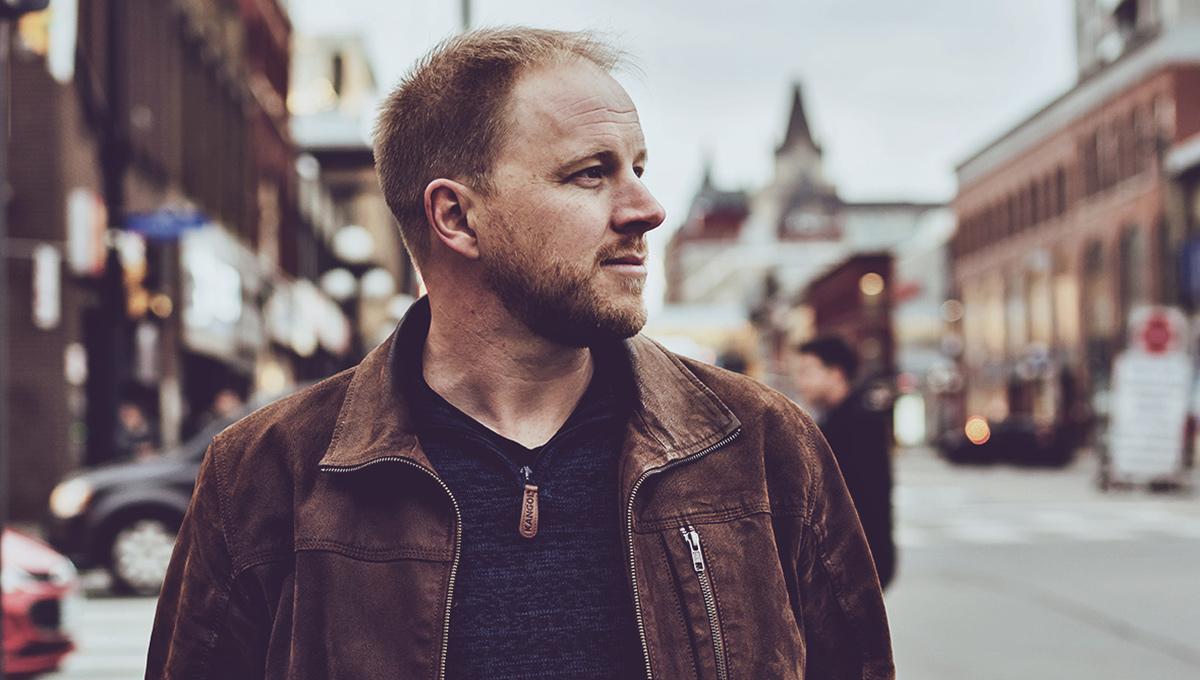
Jeff Smith
Charlotte: I’m planning to defend my master’s thesis in April. I want to make it very clear that while schools are failing homeless youth there is potential for them to help. Ensuring that teachers have the capacity to spend time with individual students to build trusting relationships would be a huge step forward. Teachers can spot problems like sexual abuse or drug abuse and direct students to appropriate support. But it’s not teachers’ fault that they’re too busy, with class sizes increasing and budgets being cut.
Jeff: The CIHR funding is wrapping up, but we received additional support through the federal government’s Impact Canada drug testing technology challenge last spring to further develop our approach. We would like to take it from simply a qualitative observation — “You have fentanyl or carfentanil” — and start telling clients the exact amounts in grams of what they have. This would be a huge transition. Currently, the best way to solve an addiction is to “taper” down and wean yourself off a drug. But without knowing what’s in your drugs, you are playing roulette every single time you inject something, and it becomes almost impossible to stop using.
Charlotte: I think we all have the capacity to put ourselves in other people’s shoes. The first step is listening to people who have been through things like homelessness or drug addiction. Harm reduction is one small drop in the bucket in terms of how we can help. A lot of people think it enables users. But if we can keep people alive and provide opportunities for mental health support, for employment support, for family reconnection, for community, one day hopefully they’ll be alive to accept an opportunity. I would have fewer dead friends if there had been safe injection sites a long time ago. My model of recovery was to find a farm, but that’s not going to work for everybody. Which is why it’s important to have a range of wonderful opportunities. “Wonderful opportunities” — that’s an oxymoron. All opportunities are wonderful. You don’t realize that until you don’t have any.
Jeff: When you go to an injection site, you realize right away that everybody who steps inside is a real person. They all came from somewhere. This project has opened my eyes to the difficult issues that we face as a society. Supervised injection sites support individuals through tough times. When somebody falls down, you lift them up. You don’t just leave them in a hole.
Charlotte: Ten years ago, I didn’t know what a master’s degree was. One day, when I was 20, I remember waking up and not even knowing my own name. I’ve never had such a fucked-up feeling: I wake up, smoke some crack and don’t know my name. So, no, I didn’t know that I’d ever go to university — and I feel so lucky that I am. I know that I have to help other people get here as well.
Jeff: I work towards cancer therapies, but cancer is such a difficult disease to understand. I’m grateful that part of my career is contributing to that base of knowledge. But this opioid research has a face to it, and it’s the most impactful work I’ve done. I think it’s extremely important for scientists to engage with the communities we serve, because the research we do is generally funded by public dollars. And I think that’s the reason that I and so many of my colleagues are into research: to understand this world better and figure out how to interact with one another in a more holistic way.
Charlotte: When I was using, I used to go to the Sandy Hill heath centre to get clean needles. Now I drop off people there pretty regularly. I try to avoid places where I’m too emotional, but I go there once a year for the annual drug user memorial. It’s a cardboard wall they bring out with pictures of people who have died. Every year, the wall gets bigger. Stigma is just like a wall. Even when you’re trying to do all the right things, you have to fight through that wall. That’s one of the reasons we’re creating a scholarship at Carleton for youth who have experienced homelessness, with help from Cora MacDonald at A Way Home Ottawa. It will cover tuition and housing. Almost all the homeless youth I’ve talked to want to go to school. I’ve been told that policies can’t involve kindness. I think that’s bullshit. One of my drug counsellors told me to get a PhD and said that if people who have been through things get into positions of power, that’s how structures become kinder. And then eventually, hopefully, we’ll have a kinder society.
